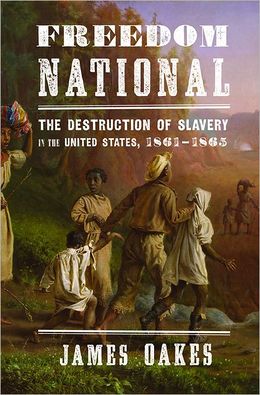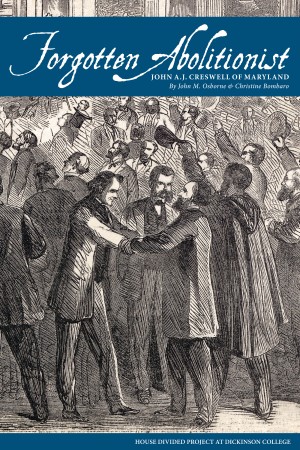 James Oakes’s Freedom National: The Destruction of Slavery in the United States, 1861-1865 (Norton, 2012) profoundly challenges the way most American history textbooks and classrooms have been presenting the story of Civil War emancipation. The nearly 500-page book contains a host of new details that complicate what can sometimes appear as a simple narrative. From Oakes’s perspective, emancipation should never be presented as a singular turning point in the war, nor should Abraham Lincoln ever stand alone in our discussions as the Great Emancipator. Instead, Oakes explains the origins and evolution of American anti-slavery policy and describes how in his opinion the Civil War was not “transformed” by President Lincoln’s actions. According to Oakes, this was never simply a war for Union that turned into a struggle for freedom, but rather a conflict where both values coincided from the beginning in the hands of several different types of historical actors, and were inextricably linked until the very end through various Republican policy initiatives, involving both the President and Congress. Here is a summary of the dozen most compelling claims from Freedom National that should have the biggest impact on classrooms and future textbooks:
James Oakes’s Freedom National: The Destruction of Slavery in the United States, 1861-1865 (Norton, 2012) profoundly challenges the way most American history textbooks and classrooms have been presenting the story of Civil War emancipation. The nearly 500-page book contains a host of new details that complicate what can sometimes appear as a simple narrative. From Oakes’s perspective, emancipation should never be presented as a singular turning point in the war, nor should Abraham Lincoln ever stand alone in our discussions as the Great Emancipator. Instead, Oakes explains the origins and evolution of American anti-slavery policy and describes how in his opinion the Civil War was not “transformed” by President Lincoln’s actions. According to Oakes, this was never simply a war for Union that turned into a struggle for freedom, but rather a conflict where both values coincided from the beginning in the hands of several different types of historical actors, and were inextricably linked until the very end through various Republican policy initiatives, involving both the President and Congress. Here is a summary of the dozen most compelling claims from Freedom National that should have the biggest impact on classrooms and future textbooks:
1. The Civil War was never simply a “war for Union” that became a “struggle for freedom.” It was always about both.
2. Most abolitionists never believed that the federal government could abolish slavery by ordinary political or legal means. Since the 1830’s, they advocated an immediate moral confrontation with slaveholders, but nearly everyone conceded in the years before the war erupted that the Constitution allowed slave states to decide the fate of the institution within their own borders.
3. Leading abolitionists, however, had long warned (well before the Civil War) that military emancipation was a legitimate option available for the national government that might be used within states to free slaves in times of war or rebellion.
4. Republican policies toward slavery were not just about containing its spread, but offered a fully-realized vision of “freedom national” that while short of advocating what was called immediate abolition, nonetheless represented a serious threat to slavery’s future.
5. Self-emancipation by thousands of slaves at the very outset of the war soon resulted in a real and surprisingly effective early emancipation measure –the so-called First Confiscation Act (August 6, 1861). This measure gained added impact by an even more radical implementation of the policy through Lincoln’s War Department.
6. Congress took several notable steps to combat slavery and promote emancipation by 1862, culminating in the Second Confiscation Act (July 17, 1862) which was an explicit attempt by Republicans on Capitol Hill to authorize universal and immediate emancipation on humanitarian grounds separate from the principles of property confiscation.
7. Lincoln’s selective actions against emancipation in the early years of the war –rescinding orders by Generals John Fremont and David Hunter, for example– have been misinterpreted and used incorrectly to overstate his disagreements with the so-called Radical Republicans –at least on the question of emancipation.
8. Lincoln’s September 22, 1862 Emancipation Proclamation was not merely a “Preliminary” one, but had immediate consequences that resulted in more freedom for tens of thousands of ex-slaves in Union-occupied areas of the South.
9. The Emancipation Proclamation (January 1, 1863) was a decisive turning point that shifted federal policy beyond earlier anti-slavery measures, but not in the way that many people claim. It was pivotal mainly because of the way it implemented new policies of enticement (encouraging slaves to leave southern plantations) and enlistment (paying black men to serve in the Union army).
10. Confederates and pro-slavery forces in the Border States launched a fierce –but now often ignored– “counterrevolution” to emancipation that in many ways made enslavement worse after 1863 and even more disruptive for black families.
11. The subsequent practical and legal limitations of wartime anti-slavery policies –only about 15 percent of southern slaves had been physically emancipated by the war’s end– eventually compelled Republicans to rally around an abolition amendment to the Constitution that explicitly revoked the old “federal consensus” about slavery within states and finally settled the question of slavery’s legal future.
12. What the destruction of slavery in America helps illustrate is that emancipation and abolition are different concepts (one frees individuals; the other changes laws) and that most Republican leaders (including Lincoln) aggressively promoted both policies simultaneously throughout most of the wartime period.
To see James Oakes in action, click on the image below to view a recent lecture he gave on “Lincoln and Race,” at a 2008 conference sponsored by Columbia University and the Gilder Lehrman Institute of American History.
James Oakes: Lincoln and Race from The Gilder Lehrman Institute on Vimeo.


Pingback: Insights from James Oakes’s, “Freedom National” (2012) | elcidharth